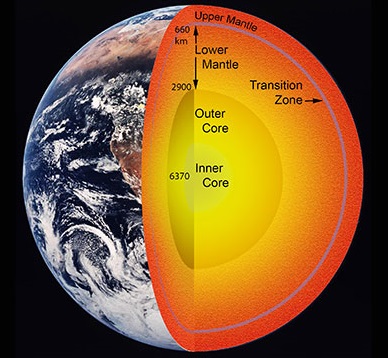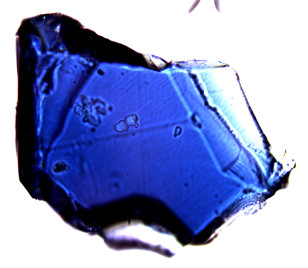
Schematic cross section of the Earth’s interior. (Northwestern University)
New evidence suggests there might be oceans of water far beneath Earth’s surface.
Northwestern University geophysicist Steve Jacobsen, along with University of New Mexico seismologist Brandon Schmandt, found evidence of water in pockets of hot magma about 645 km beneath North America within the transition zone between Earth’s upper and lower mantle.
“It alters our previous understanding of the composition of the Earth,” said Jacobsen, adding that Earth might have far more H2O than was previously thought.
“It [also] has some implications for where Earth’s water came from, from inside [the Earth] versus comets,” Jacobsen said.
Even though this deep-Earth water isn’t in the form we’re used to, such as liquid, ice or even vapor, researchers say their discovery could still turn out to be one of our planet’s largest water reservoirs.
Not only will the findings help determine just how much water is trapped inside rock in the transition zone, but they will also provide scientists with unique insight into the composition of Earth’s structure, how it was formed, and the complex processes that are taking place deep inside our planet.
The study augments another, by a Canadian-led team, that discovered water deep within Earth hydrous minerals that were pushed to the surface by volcanoes.
Jacobsen and Schmandt believe that plate tectonics may be responsible for driving water so far down into the Earth.
“We’re trying to connect the rock cycles, which some people know as plate tectonics, with the water cycle,” said Jacobsen.
There are instances where tectonic plates come together and one of them dives deep down from the crust into the mantle, beneath the other, in a process called subduction.
There are times during subduction when water is taken down into the mantle in the form of hydrous minerals, such as ringwoodite. This form of water often doesn’t make it that far down into the mantle.
Typically, within the upper 100 kilometers or so into the mantle, temperatures become so hot and the pressures become so high, that those hydrous minerals begin breaking down to form other minerals. But, in doing this, the minerals also release some water in a process called dehydration melting, which Jacobsen said is also the source of magma in all volcanoes .
The huge amounts of water described by the researchers are trapped within the molecular structure of minerals that are contained in the mantle rock.
The researchers say that even if only 1percent of the weight of transition zone rock had trapped water inside, that amount of water would be equal to about three times the water that’s held in our oceans.
Since the minerals are subjected to such immense pressure and high temperatures, water molecules that become bound within the mineral’s crystal structure actually split and form something called hydroxyl radicals.
As these OH rich minerals come up to the surface of the Earth and are melted through geological events such volcanic eruptions, the OH molecules regroup and form actual water (H20) molecules and are expelled as water vapor.
The research team believes that this deep Earth water is connected with surface reservoirs.
“You can probably recycle all of the water in the oceans, through the upper mantle, once every 100 million years or so,” said Jacobsen.
The research Schmandt conducted was based on seismic data produced by USArray, a network of some 2,000 seismometers that have been placed throughout the US. Jacobsen replicates the pressure and temperatures found deep inside the Earth through various laboratory experiments and then studies the geophysical processes that are taking place so far beneath the surface of the Earth, that direct observation isn’t possible.
“We don’t know much yet, about this deeper reservoir, which could be potentially as large as the oceans or maybe even more than that,” said Jacobsen.























Thanks to the sons of men who are discovering all this,may be some day this water will be
of some use.
The “sons of men who have discovered this”…..is it not possible that women have also contributed to geophysical discoveries or are you just a sexist from a backward continent?
Thank you for this article, it has become very useful for my chemistry presentation.
From Barry Bunwin XD
I assume that all the moisture created from the heat of Earth’s core had to go somewhere? Steam cools down and turns into water drops, right? The theory seems sound to me. Great article.